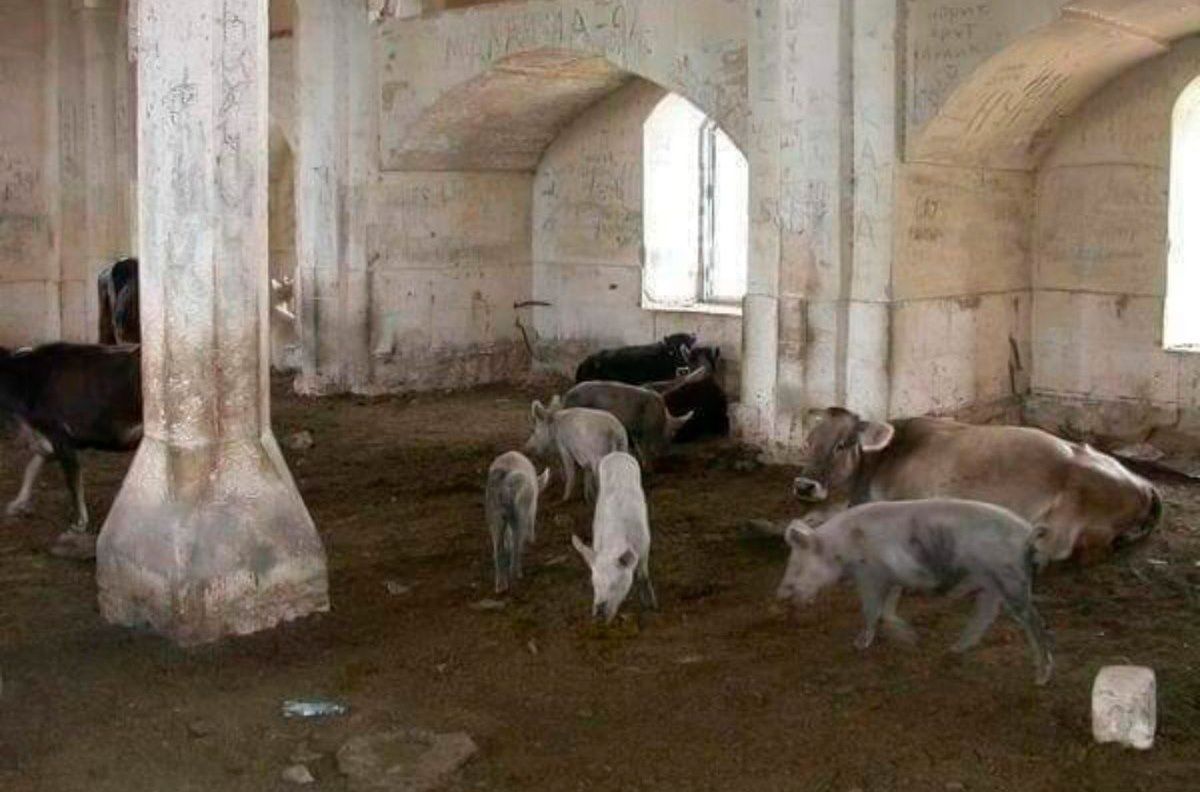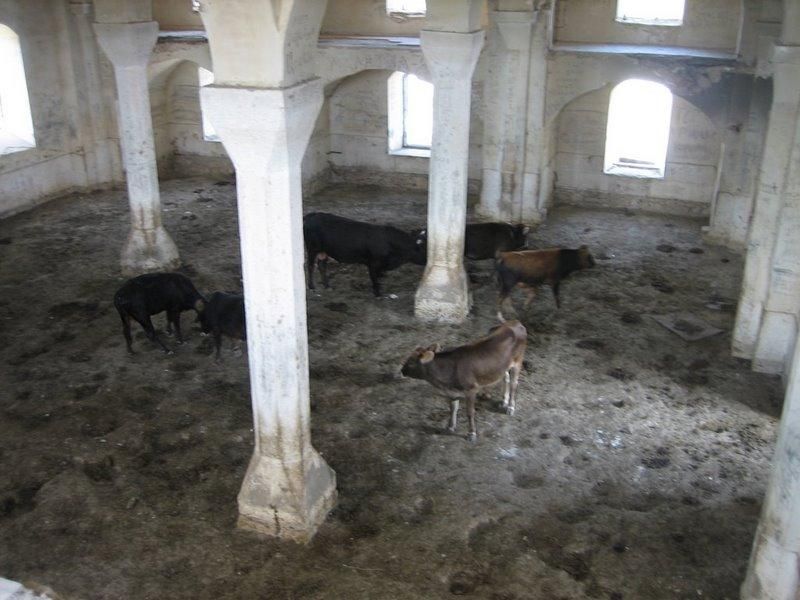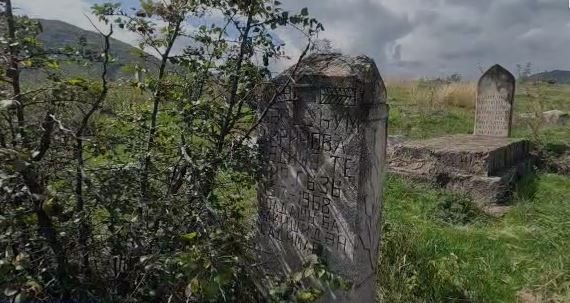|
|
TODAY.AZ / Politics
Cultural genocide in liberated territories: indelible traces of Armenian vandalism
06 October 2023 [22:00] - TODAY.AZ

By Azernews
During 33 years of occupation of the territories of Azerbaijan by Armenia, Armenian separatists, and their clans have been destroying the Azerbaijani heritage of the historical culture of their ancestors, including mosques, and religious, historical, and cultural monuments. These acts of vandalism and desecration stem from hatred towards neighbors, and religious, cultural, and historical values, which are not inherent to Armenians.
A lot of reports were introduced to cover the act of vandalism committed by Armenians, but it did not receive much publicity in the world media circle.

To illustrate the point, Armenians used mosques in the occupied lands of Azerbaijan as cattle pens, stables, and horse stalls. Having no proper respect for religious monuments, mosques, as well as sacred places, vandals continued their heinous actions even after the Patriotic War.
The destruction of Azerbaijan's material and cultural heritage by Armenians is an act of vandalism not only against Azerbaijan but also against human values. Destruction of mosques and their looting, and appropriation of material-cultural and religious monuments is part of the barbaric ideology of Armenians.
Even today, although Azerbaijan liberated its lands from occupation, it is possible to clearly see Armenian vandalism on those destroyed religious and cultural monuments.

The mosque in Aghdam, dating back to the 19th century, was destroyed and looted and later used as a pig stall. According to official data, there are 403 historical-religious monuments in the occupied territories, of which 67 are mosques, 144 are temples, 192 are sanctuaries, 67 Muslim mosques (13 in Shusha, 5 in Aghdam, 16 in Fuzuli, 12 in Zangilan, 5 in Jabrail, 8 in Gubadli and 8 in Lachin) were completely destroyed by Armenians.

"The destruction of religious monuments in Garabagh by Armenia is a tragedy," said Salim bin Mohammed al-Malik, head of the Islamic World Education, Science and Culture Organization (ICESCO).
"The scene we see here (Garabagh) is a real tragedy. When we visited the liberated lands, we saw the destruction of all the villages, townships, and historical and religious monuments. Destruction of mosques and religious temples, insult and vandalism is an absolutely unacceptable action," al-Malik said during a visit to Azerbaijan's districts liberated from occupation.
22 museums and museum branches were destroyed, where more than 100 thousand cultural artifacts and relics were stored, which were later exported and sold on the black market. Cultural samples and ancient manuscripts of the 13th century Khudaveng monastery in Kalbajar district, as well as valuable exhibits discovered during archaeological excavations near Shahbulag fortress in Aghdam district, were smuggled to Armenia.
Gross violation of international humanitarian law, including UNESCO normative documents, such as the 1954 Hague Convention, its two protocols, as well as the 1970 Convention.
It is important to emphasize that 2000 monuments of Armenian history and culture remain in the territories that came under Azerbaijani control, including 161 monasteries and churches, 591 khachkars (cross-stones), the excavation sites of Tigranakert, Azokh, Nor Karmiravan, Mirik, Keren and numerous fortresses, castles, shrines and other monuments. There are eight state museums with 19,311 exhibits along with the private museum of carpets and the Armenian Drama Museum in Shusha,
Today no one disputes that in war a bullet or a shell spares no one - neither people, nor buildings, nor monuments of history and culture. This is war, and everything happens in it. But if the destruction of a building during the war can still be explained, how can we explain the vandalism of Armenian invaders in non-war times? After all, the destruction of Azerbaijani and Albanian historical and cultural heritage in Garabagh and Armenia took place during the years of ceasefire.
More than 900 Muslim cemeteries were destroyed and vandalized in these territories. Moreover, traces of illegal "archaeological excavations" and so-called "reconstruction works" were discovered in the liberated territories of Azerbaijan.

All this confirms the fact that the Armenian side tried to conceal and falsify cultural, historical, and scientific evidence. For example, an equipped workshop for the production of "ancient" cross-stones was discovered in the Kalbajar district. These cross-stones were subjected to oxidation and treated with vinegar in order to age artificially and then buried in the ground to be used as undeniable evidence of "centuries-old Armenian roots" in the Garabagh region.

Armenians left a centuries-old trace in Garadaghli village, where a huge number of destroyed monuments, desecrated graves, and monuments were found during the anti-terrorist operation carried out by the Azerbaijani army on 19 September 2023 to eradicate terrorists from Garabagh.
The tragedy of Garadaghli, which resulted in the orphaning of 146 children, is one of the bloodiest pages of the genocide policy carried out by Armenians against the people of Azerbaijan to achieve their evil intentions.
URL: http://www.today.az/news/politics/239793.html
 Print version
Print version
Connect with us. Get latest news and updates.
See Also
- 26 April 2025 [18:23]
Azerbaijani delegation meets local community in Georgia’s Qabal village - 26 April 2025 [16:45]
Azerbaijan and Pakistan FMs hold phone conversation on strategic partnership & regional security - 26 April 2025 [15:46]
World travelers visit mine clearance site in Jabrayil’s Mehdili village - 26 April 2025 [14:22]
Prosecutor’s office holds tree-planting campaign in honor of National Leader Heydar Aliyev’s 102nd anniversary - 26 April 2025 [13:28]
President of Uzbekistan makes phone call to President Ilham Aliyev - 26 April 2025 [13:08]
President Ilham Aliyev gives interview to China's CGTN television channel in Beijing - 26 April 2025 [12:49]
Azerbaijan and Switzerland hold political consultations in Bern - 26 April 2025 [10:00]
Azerbaijan seeks OSCE support for mine clearance in liberated areas - 25 April 2025 [15:19]
Kaja Kallas: EU-Azerbaijan ties advancing on a ‘two-way path’ - 25 April 2025 [13:22]
Azerbaijan, Uzbekistan hold working meeting on defense cooperation in Baku
Most Popular
 Turkiye opens new chapter in space with TÜRKSAT 6A
Turkiye opens new chapter in space with TÜRKSAT 6A
 Khankendi to host 17th Economic Cooperation Organization Summit
Khankendi to host 17th Economic Cooperation Organization Summit
 Armenia's accusations are misinformation, says Azerbaijani Defense Ministry
Armenia's accusations are misinformation, says Azerbaijani Defense Ministry
 China send its next space mission into orbit
China send its next space mission into orbit
 Ankara, Washington seek common ground on customs tariffs
Ankara, Washington seek common ground on customs tariffs
 Kaja Kallas: EU-Azerbaijan ties advancing on a ‘two-way path’
Kaja Kallas: EU-Azerbaijan ties advancing on a ‘two-way path’
 VP of Heydar Aliyev Foundation visits Chinese National Human Genome Center
VP of Heydar Aliyev Foundation visits Chinese National Human Genome Center
